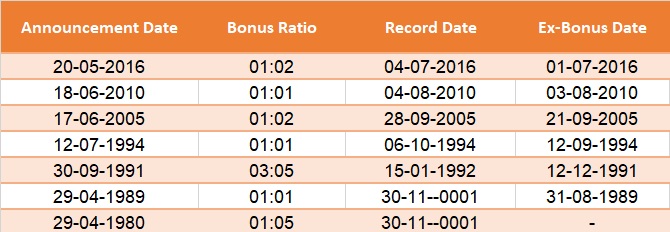Recovery of Unclaimed Wipro Limited Shares Transferred to the IEPF
Wipro Limited (NYSE: WIT, BSE: 507685, NSE: WIPRO) is one of the leading providers of technology and consulting services, specializing in pioneering solutions tailored to meet the complex needs of clients navigating digital transformation. Leveraging the expertise spanning consulting, design, engineering, operations, and emerging technologies, they empower customers to achieve ambitious objectives and build resilient, enduring enterprises.
With a global presence spanning 66 countries and a workforce exceeding 250,000 dedicated professionals, Wipro is renowned worldwide for its comprehensive service portfolio, commitment to sustainability, and exemplary corporate responsibility practices.
The Value Wipro Has Created Over 22 Years
Before discussing the process of claiming Wipro's unclaimed shares and dividends transferred to the  Investor Education and Protection Fund (IEPF), let's explore the significance of claiming these shares and dividends. Since its listing on stock exchanges, Wipro's shares have consistently been top performers in the stock market.
For instance, in the year 2000, the per-share price of Wipro was approximately Rs. 52. As of June 19, 2024, this price has increased to Rs. 495.25, excluding any bonuses or splits.
Let’s consider a hypothetical scenario where you purchased 100 shares of Wipro in 2000 at Rs. 52 per share:
Initial Investment: 100 shares * Rs. 52 = Rs. 5200
Bonus Shares History:
a) Bonus Shares on June 25, 2004 (2:1)
   - Number of Shares after bonus: 100 shares * 3 = 300 shares
b) Bonus Shares on August 22, 2005 (1:1)
   - Number of Shares after bonus: 300 shares * 2 = 600 shares
c) Bonus Shares on June 15, 2010 (2:3)
   - Number of Shares after bonus: 600 shares * 5/3 = 1000 shares
d) Bonus Shares on June 13, 2017 (1:1)
   - Number of Shares after bonus: 1000 shares * 2 = 2000 shares
e) Bonus Shares on June 6, 2019 (1:3)
   - Number of Shares after bonus: 2000 shares * 4/3 = 2666 shares
Thus, if you initially purchased 100 shares in 2000, you would now own 2666 shares after all the bonus issues.
Current Market Value:
Current Market Price of Wipro (as of June 19, 2024): Rs. 495.25 per share
Total Value of Investment Now: 2666 shares * Rs. 495.25 = Rs. 1,320,716.50 (~13.2 lakhs)
Therefore, an initial investment of Rs. 5200 in Wipro shares in 2000 would be worth approximately Rs. 13.2 lakhs as of June 2024, not accounting for any dividends received over the years. If your shares have gone to IEPF, this represents a substantial value, making IEPF claim  of your shares and dividends a mandatory task to realize this significant financial benefit.
Wipro Share Price Chart from the Beginning:

Wipro Dividend History Table:

Source: https://www.moneycontrol.com/company-facts/wipro/dividends/W
Issue of Duplicate Share Certificate- The Steps
Physical share certificates are critical as they serve as proof of share ownership. However, these certificates can sometimes be destroyed, misplaced, forgotten, or lost due to various circumstances.
Recently, an individual approached Share Samadhan, the leading share recovery firm in Delhi for recovering shares and dividends from IEPF, assistance in issuing duplicate share certificates, and converting physical shares to Demat. This person, a shareholder of Wipro, had obtained a physical share certificate at the time of purchase. Unfortunately, a fire disaster led to the loss of his share certificate, and he had not claimed dividends for an extended period. Our investigation revealed that his shares had been transferred to the IEPF (Investors Education and Protection Fund).
To initiate the IEPF claim for these shares and dividends, a duplicate share certificate was required as the original proof of ownership was lost. The only evidence available was a dividend check. Using this, we initiated the procedure of issuing a duplicate share certificate. We advised him to immediately file a complaint and obtain a copy of the FIR at the local police station.
Upon receiving the FIR copy, we submitted the necessary documents to request a duplicate share certificate. These documents included:
- A canceled check leaf
- Folio number
- Share certificate number
- PAN card
- Aadhaar card
- Email address
- Mobile number
Some clients who visited us in person for a duplicate share certificate were able to complete the process quickly and easily. However, a few clients had to leave due to professional commitments, causing delays in providing the required documentation, which unfortunately resulted in their shares being transferred to IEPF.
To avoid such delays and expedite the process, we recommend being present and responsive when we request documentation.
Process for Deceased Shareholders
When an individual purchases shares from a company, they become a shareholder. Historically, shares were bought using physical share certificates. If a shareholder dies, the nominee or legal successor must inform the company. They should also report any lost or forgotten share certificates by email or letter. If a nominee is named on the share certificate, they can request the transfer of shares and apply for a duplicate share certificate.
By adhering to these procedures and promptly providing the necessary documentation, shareholders and their heirs can ensure the share recovery and transfer of shares and dividends, safeguarding their investments.
Share Samadhan for the Recovery of Wipro Shares
Many of Share Samadhan's clients have successfully obtained duplicate share certificates, even when the original shareholder or investor had passed away.
Recently, one of our clients sought our help in recovering unclaimed dividends and shares, as well as obtaining a duplicate share certificate.
In this case, Mr. Aman Ahuja purchased 200 shares of Wipro Ltd. in 2004 in the form of physical share certificates. Unfortunately, in 2009, he misplaced the actual share certificate. Mr. Ahuja became bedridden due to illness in 2011 and subsequently passed away in 2014. Since dividends for the shares had not been claimed for seven consecutive years, the unclaimed shares  and dividends  were transferred to IEPF  in 2019.
Wipro Ltd. issued a 1:1 bonus in 2006, doubling the number of shares to 400. In 2009 and 2018, Wipro again distributed bonuses at a 1:1 ratio, further increasing the total shares to 1600. As of 2018, the entire market value of these shares was 33 lakh Indian rupees.
Mr. Ahuja's wife, Mrs. Smriti Ahuja, approached us to handle the situation and reclaim the shares and dividends from IEPF. Given that the primary ownership document was missing, we initiated the procedure for issuing a duplicate share certificate. To apply for this, we required several documents, including:
- The investor’s death certificate
- PAN cards of family members
- The successor’s succession certificate
- The successor’s attested signature from their bank
- Address proof
- Folio number
- Shareholder's address (as the nominee or legal heir)
- Share certificate number
- PAN card
- Aadhaar card
- Email address
- Mobile phone number
Mrs. Ahuja provided the necessary documentation, and we commenced the process of requesting a duplicate share certificate. Once we received the duplicate share certificate, we successfully recovered the unclaimed shares and dividends from IEPF. Mrs. Ahuja then claimed the unclaimed dividends and the shares were transferred to her name.
This case highlights the importance of keeping share certificates safe and ensuring timely claims of dividends to avoid the transfer of shares to IEPF. If you find yourself in a similar situation, Share Samadhan can provide expert assistance in recovering your shares and dividends.
Handling Situations When Both the Shareholder and Nominee Are Deceased
Shareholders often have the option to designate a nominee for their shares. Most investors add nominee information when purchasing shares in physical form, although some fail to do so. When a shareholder or investor passes away, it is relatively straightforward for the nominee to obtain a duplicate share certificate if the original is lost, missing, burned, or forgotten. However, the process becomes more complicated and time-consuming if the nominee's information was not recorded.
In cases where both the shareholder and nominee have passed away, the legal successor or family members can request a duplicate share certificate. At Share Samadhan, our professional team has a track record of successfully assisting clients in such situations.
Obtaining a Duplicate Share Certificate When Both the Shareholder and Nominee Are Deceased
Shares Transferred to IEPF
If dividends are not claimed for seven years or more, shares are transferred to the Investor Education and Protection Fund (IEPF). Obtaining a duplicate share certificate from IEPF under these circumstances can be a lengthy process, especially when both the shareholder and nominee are deceased and the original share certificate is missing.
Here is a case we resolved that may help you understand the regular procedure to obtain a duplicate share certificate from IEPF.
A client approached us as the legal heir of a deceased shareholder. His father owned 500 shares of Reliance Industries Ltd. since 2004, with his mother as the nominee. Unfortunately, both parents passed away, and the physical share certificate was lost. The only proof available was a dividend check in his father's name.
Using the information from the dividend check, we investigated and discovered that the company had issued a total of 2000 shares with bonuses, all transferred to IEPF. Our team worked diligently with IEPF to secure a duplicate share certificate. Once obtained, we proceeded to reclaim the unclaimed dividends and transfer ownership of the shares to our client. The necessary documents included dividend checks, KYC records, death certificates for both the shareholder and nominee, family members' no-objection certificates, legal heir certificates, and succession certificates.
Shares Still Held by the Company
If the shares have not been transferred to IEPF, the process is simpler but follows a similar procedure. We contact the company directly to obtain the duplicate share certificate. Once the duplicate certificate is received, we can transfer the shares and claim any unpaid dividends. Required documents include dividend checks, KYC records, death certificates for the shareholder and nominee, no-objection certificates from family members, legal heir certificates, and succession certificates.
Steps to Take
1. Collect Necessary Documents:
   - Dividend checks
   - KYC records
   - Death certificates of the shareholder and nominee
   - No-objection certificates from family members
   - Legal heir certificate
   - Succession certificate
Â
2. Contact Share Samadhan:
   - Provide the collected documents.
   - We will initiate the process of obtaining a duplicate share certificate.
Â
3. Follow Through:
   - Once the duplicate certificate is obtained, we will help you reclaim unpaid dividends and transfer the shares to the legal successor.
Â
By following these steps and providing the required documentation promptly, you can ensure the recovery and transfer of shares and dividends, safeguarding the legacy and investments of your loved ones.
Â
CONCLUSION
At Share Samadhan, 50% of the cases we handle involve unclaimed shares transferred to the  Investor Education and Protection Fund (IEPF) due to address changes. If you have lost your physical share certificate and have moved to a new address, we recommend updating your address with the relevant authorities. If your shares are still active with the issuing firm, you can directly contact them to update your address and request a duplicate share certificate. However, if your unclaimed shares and dividends have already been transferred to the IEPF, updating your address and obtaining a duplicate share certificate can take some time. Share Samadhan can assist you in receiving a duplicate share certificate from the IEPF. We have a proven track record of successfully updating our clients’ addresses and securing duplicate share certificates from the IEPF.









